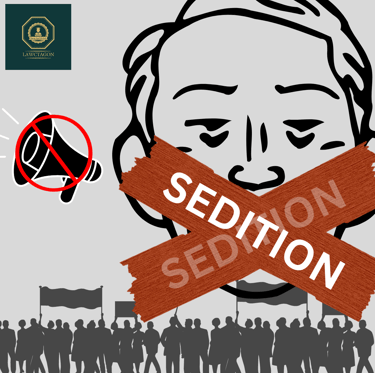Sedition Under IPC, its History and Latest Development
In this blog, the meaning and definition of sedition under IPC, the controversies surrounding sedition and how it is allegedly violative of articles 14, 19 and 21, have been discussed with relevant case laws. Further, the current and latest stance of the Supreme Court in the matter has been explained.
Suraj
5/4/20247 min read


Sedition Under IPC, its History and Latest Development
TABLE OF CONTENTS
Sedition Under IPC, its History and Latest Development
What is Sedition?
Sedition refers to the act of inciting rebellion or violence against the government. It involves speech, writing, or behaviour that encourages people to rebel against the established order, undermines the authority of the government, or promotes hostility, hatred, or violence towards it. In India, sedition has a contentious history, dating back to the colonial period under British rule.
For the longest period, we have read sedition under section 124A of the Indian Penal Code, before the enactment of new penal codes. The key words in section 124A are “whoever...brings or attempts to bring into hatred or contempt, or excites or attempts to excite disaffection towards, the Government…”.
The new law, Bharatiya Nyaya Sanhita (BNS), however, uses different keywords. It says, “whoever…excites or attempts to excite, secession or armed rebellion or subversive activities, or encourages feelings of separatist activities or endangers sovereignty or unity and integrity of India; or indulges in or commits any such act…”
Mr. Sibal, while being present in the SC during the hearing of- whether sedition under art. 124A is constitutionally valid, famously said “the new clause proposed in place of Section 124A was ‘unfortunately worse’. Section 150 in the Bharatiya Nyaya Sanhita Bill avoids using the term ‘sedition’, but describes the offence as any act ‘endangering sovereignty, unity and integrity of India’. What they have proposed is far more draconian”
But in this blog, we are not having a comparative analysis of the old and new law, rather we will try to understand the journey of sedition law till now. Let us start with its history.
History of Sedition
Historically, section 124A has always been controversial since its first recorded case in the form of Queen Empress v. Jogendra Chunder Bose[1]. Soon thereafter, in Queen Empress v. Ramchandra Narayan & Anr[2], the Full Bench of Bombay High Court, (Sir Charles Farran, C. J., Justice Parsons and Justice Ranade), convicted the Editor (a party in the case). Most importantly it is significant to notice the manner in which Justice Ranade captured the meaning of the word “Disaffection” in the concerned section. The same is extracted below:
“Disaffection, as thus judicially paraphrased, is a positive political distemper, and not a mere absence or negation of love or good-will. It is a positive feeling of aversion which is akin to ‘disloyalty’, a defiant in-subordination of authority, or when it is not defiant, it secretly seeks to alienate the people, and weaken the bond of allegiance, and possesses the minds of the people with avowed or secret animosity to Government, a feeling which tends to bring the Government into hatred or contempt by imputing base of corrupt motives to it, make men indisposed to obey or support the laws of the realm, and promotes discontent and public disorder”.
The law was amended in 1897, substituting the provision as it exists today in the form of section 124A.
Fast forward to 1962 when SC, once and for all decided the matter with a constitutional bench. The validity of the impugned provision was upheld by a constitution bench of this Hon’ble Court in Kedar Nath Singh v. State of Bihar[3]. Consequently, the SC construed the concerned provision so as to save it from being rendered unconstitutional, and held that it only punished speech that is “intended or has a tendency, to create disorder or disturbance of public peace by resort to violence”.
Legal Challenges to Sedition
In numerous cases, legal lacunas in the bare language of the provision, controversial approaches in its implementation and in the reasoning provided by the Hon’ble SC in the Kedar Nath Singh judgement has been pointed out. People argue that the decision in Kedar Nath Singh requires reconsideration and as the Hon’ble Court has misconstrued and misunderstood the Federal court judgement of Nihrendu Dutt Majumdar v. King Emperor[4] where Sir Maurice held that in case of public order offences, “the acts or words complained of must, either incite to disorder or must be such as to satisfy reasonable men that that is their intention or tendency”. According to the test, the gravamen of the offence is incitement to disorder. However, in Kedar Nath Singh, SC held that “if we accept the interpretation of the federal court as to the gist of criminality in an alleged crime of sedition, namely, incitement to disorder or tendency or likelihood of pubic disorder…” Therefore, Hon’ble Court removed the requirement of incitement and thereby the requirement of proximity between the acts/words and public disorder.
The “tendency” test in Kedar Nath Singh is inconsistent both with precedents before and also after with fifty years of consistent jurisprudence after 1962 which can be seen in a series of judgements. In S. Rangarajan v. P. Jagjivan Ram[5], SC held that the relationship between speech and disorder must be akin to a “spark in a powder keg”.
It has been argued that by criminalizing dissent and criticism, this law stifles open discourse and suppresses legitimate grievances. In the name of preserving order, it silences voices that are crucial for societal progress and democratic accountability. Hence, it is violative of Article 19, which guarantees the right to freedom of speech and expression
Secondly, it has been argued that the concerned section violates 4 subcomponents of proportionality which the Hon’ble SC Court stated in Modern Dental College & Research Center v. State of Madhya Pradesh[6] and later affirmed in KS Puttaswamy v. Union of India[7]. The 4 components of proportionality which are used to determine the permissible infringement on Fundamental Rights are:
a) A measure restricting a right must have a legitimate goal (Legitimacy goal stage)
b) It must be a suitable means of furthering this goal (suitability stage)
c) There must not be equally effective but less restrictive alternatives (necessity stage)
d) The measure must not have a disproportionate impact on the right-holder (Balancing stage).
Thirdly, this section prescribes a punishment regime, unlike any other offence under the. Section 124A in effect contains three different offences within itself and permits judges to punish an accused with (1) imprisonment for life, to which a fine may be added or (2) only imprisonment which may extend to three years, to which a fine may be added or (3) only fine. This vast range of punishments has been said to violate the classification doctrine.
New Legal Challenge
The constitutional bench in Kedar Nath propounded the judgement based on the legal jurisprudence of 1962. It is pertinent to note that legal jurisprudence has evolved a lot since 1962, especially the scope of Fundamental rights. In Maneka Gandhi v. Union of India 1978 AIR 597[8], the Supreme Court expanded the scope of Article 21 to include the right to life and personal liberty. It held that this right is not merely confined to physical existence but encompasses a range of freedoms essential for a meaningful life. The chilling effect, which suppresses freedom of speech and expression, directly infringes upon this expanded interpretation of Article 21.
It has been said that sedition violates Article 21 as it jeopardizes individuals' right to personal liberty and dignity. The arbitrary enforcement of sedition laws leads to wrongful arrests and imprisonment without proper legal procedure, as in the instant case. It creates a climate of fear and intimidation, infringing upon individuals' right to express dissenting views without fear of persecution. Additionally, sedition laws undermine the right to a dignified life by stifling freedom of expression, which is essential for the functioning of a democratic society.
Latest Development in Sedition Law
Since 5th May, the Supreme Court of India has ordered that the sedition law under Section 124A of the Indian Penal Code (IPC) be kept in abeyance until the Union Government reconsiders the provision. The court also ordered that no coercive action be taken in pending sedition cases while the Union re-examines the law.
Supreme Court has referred the case to a 5-judge bench which is supposed to hear to the matter in 2024. The Chief Justice said the ambit of the Kedar Nath judgment was confined to the impact of sedition on free speech and expression enshrined in Article 19(1)(a) of the Constitution. It had not touched upon the effect of Section 124A on the fundamental rights to life (Article 21) and equal treatment (Article 14). The court said the Kedar Nath judgment had to be re-evaluated taking into consideration the substantial advancements made in recognising and evolving new rights since 1962.
“As a three-judge Bench, we cannot review the Kedar Nath judgment. Let a five-judge Bench review the 1962 judgment. In case, it says the 1962 judgment does not require modifications and sends it back to us, we are bound by it. The five-judge Bench can also refer to a seven-judge Bench or it can even make modifications in the interpretation of Section 124A to suit the present times,” CJI said.
Conclusion
Sedition, defined as inciting rebellion against the government, has a contentious history in India, primarily under Section 124A of the Indian Penal Code. Challenges to its constitutionality have arisen due to its vague language and harsh penalties. The Supreme Court's 1962 ruling in Kedar Nath Singh v. State of Bihar upheld its validity but Legal challenges have arisen since then. It has been argued that this interpretation is inconsistent with prior and subsequent jurisprudence. Recent scrutiny prompted the Supreme Court to stay sedition cases and refer the matter to a larger bench for review in 2024. Critics argue sedition violates Article 14’s right to equality, Article 19's freedom of speech and expression and Article 21's right to life, while its arbitrary enforcement undermines democratic principles. The ongoing legal debate seeks to reconcile sedition laws with evolving constitutional rights and contemporary societal norms.
References
[1] Queen Empress v. Jogendra Chunder Bose & Ors (1892) ILR 19CAL35
[2] Queen Empress v. Ramchandra Narayan & Anr 22 Bom. 152
[3] Kedar Nath Singh v. State of Bihar, 1962 Supp (2) SCR 769
[4] Nihrendu Dutt Majumdar v. King Emperor, 1942 FCR 38
[5] S. Rangarajan v. P. Jagjivan Ram, 1989 SCR (2) 204
[6] Modern Dental College & Research Center v. State of Madhya Pradesh, (2016) 7 SCC 353
[7] KS Puttaswamy v. Union of India, AIR 2018 SC (SUPP) 1841
[8] Maneka Gandhi v. Union of India 1978 AIR 597


